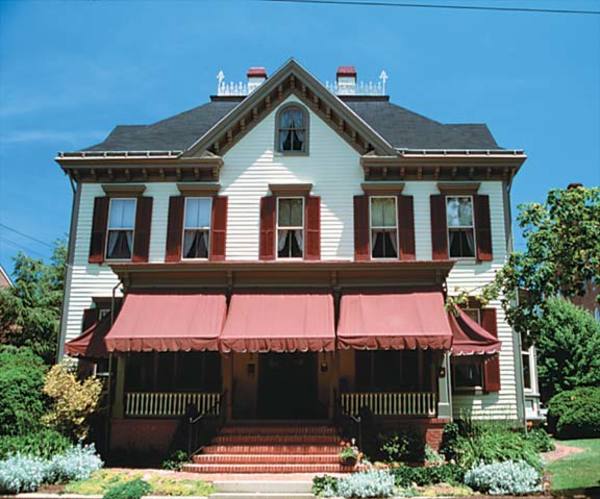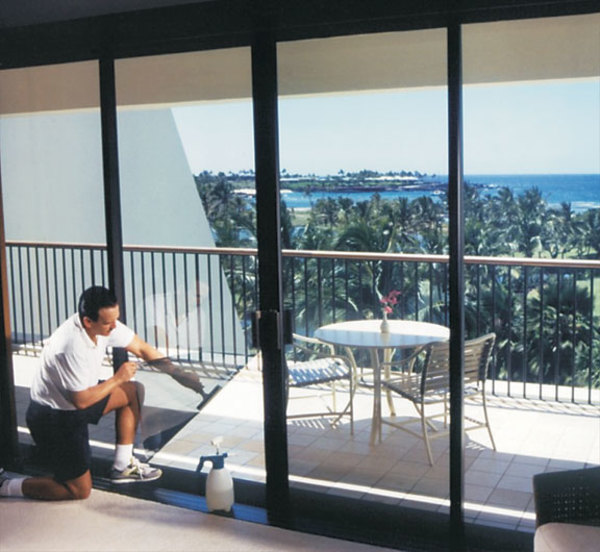
Exterior shutters and awnings are a time-honored means of blocking sunlight. (Photo: Gracie Davies)
Controlling light is an old issue with houses. Historically, builders went to great lengths to bring natural light into a house, particularly prior to the advent of electric lighting. On the other hand, homeowners have always understood the need to protect the house and its contents from the sun’s damaging rays. Shutters, awnings, and deep porches are but a few of the architectural features used in the past to control light. Today these low-tech methods are still appropriate for old houses, but we can also take advantage of some high-tech materials and approaches.
Light and Damage
Light can cause materials to fade, discolor, and literally fall apart. Light damage is most obvious with textiles, such as upholstery and carpets, but it can also fade wallpaper, photographs, and artwork, such as paintings and posters. On furniture and built-ins it can harm finishes, such as varnishes and paints, and degrade unpainted wood.
Dermatologists warn us to cover up outdoors and wear sunblock to filter out the ultra-violet (UV) component of the sun’s rays. UV radiation degrades materials by attacking their molecular structure, and this is equally true for your skin and the materials in your home. UV is highly energetic and a little exposure to it can do a lot of damage. Visible light also causes damage, but at a slower rate. Infrared radiation causes mechanical and chemical changes, making organic materials (wood, leather, and paper) dry and brittle. It’s important to remember that there is no level below which light is inactive and that light damage is cumulative and permanent. Maintaining light-sensitive materials in low light will slow their degradation but not stop it.
Traditional Protection

The amount of fading varies with fabric and dye. After three months of exposure, the bottom swatches at right are showing their inferior color retention.
For hundreds of years, homeowners added internal or external shutters to block the sun (as well as wind, rain, and prying eyes). About a century ago, manufacturers developed lightweight steel-pipe frames that made awnings popular for keeping sunlight out of buildings. Draperies and blinds serve a similar purpose and all, not coincidentally, help decorate the house. In Successful Houses and How to Build Them (1912), architect Charles E. White wrote, “Awnings add a pretty touch of color to houses in the summer-time. They add quite a festive appearance and are, besides, useful in making rooms cooler during hot days.”
Most of us know well that we’ll extend the life of wood outdoors by keeping it painted. Paint protects wood from deterioration by helping it shed water and shielding it from the sun’s rays. The pigments in paint not only add color, but also block and reflect light. (This is why varnish and other pigmentless, clear finishes only last a few years outdoors.) However, paint can also be adversely affected by light. Light causes the polymers that make up a paint coat to become brittle and break down. Paint manufacturers now engineer UV absorbers into their exterior-grade paint to extend its life and reduce maintenance.
Energy-Absorbing Solutions
Many OHJ readers may remember the days when storefront windows, particularly those of clothing shops, were fitted with yellow plastic blinds. Shopkeepers would pull the blinds down at closing time to protect merchandise from the sun. The reason is, yellow absorbs UV light and these blinds were an early form of UV screening. (This is also why beer often comes in amber-colored bottles.)
In fact, common clear window glass alone will absorb much of the UV radiation from the sun, but not enough to prevent damage to interior surfaces. Today’s low-E (low emissivity) windows, which some people install primarily to reduce heat loss, have a microscopically thin metallic layer that also absorbs UV light, possibly as much as 85 percent. Many of us prefer not to replace our old windows, however, because we love the wavy glass, the divided sashes—or because new ones aren’t in the budget. Fortunately, there’s a much less expensive option: clear UV filtering products, which can increase UV absorption to 99 percent. These can be polyester plastic film, such as Mylar, or a rigid sheet made of acrylic (like Plexiglas) or polycarbonate.
Plastic films are commonly adhered directly to the window. They aren’t appropriate for all windows, particularly very old glass. Eventually they need replacing, and must be removed using solvents and elbow grease. The process can break or scratch old glass, and the solvents can damage paint or finishes. You can also buy the films incorporated into roller blinds, though, and the rigid plastic sheets attach to the inside of the window or hang in front of it.

Modern UV films are best applied by professionals, especially to large expanses of glass. (Photo: Courtesy Vista Window Film)
The products all work by absorbing UV. Manufacturers may incorporate the absorber into the adhesive, build it into the plastic, or apply it to the surface of the plastic. The physics behind light waves is complicated (see sidebar next page). In essence though, visible light waves striking a pane of glass set up a chain of both absorptions and re-emissions. UV (and infrared) waves vibrate atoms or even molecules in the material, increasing internal energy and heat, but pass through much less readily. Films extend the range of wavelengths that are absorbed. The process of absorbing UV makes films yellow over time. Like those early storefront blinds they’re better absorbers as a result, but they soon begin to crack, allowing UV to leak through.
These products only eliminate the UV portion of the spectrum. To eliminate UV and reduce visible and infrared radiation, you must consider a solar film. These films are tinted and/or have a metallic mirrored surface, a look that can change the character of a house. Obtain samples from the manufacturer first. You might decide that installing sheer drapes (an old-fashioned solar film) suits your old house far better.
It’s recommended that a UV or solar film applied directly to your windows be professionally installed. Otherwise, many manufacturers and distributors won’t stand behind their products. Some films carry guarantees for as long as 20 years. Read the fine print on care, since some films are easily scratched or lifted from the glass during cleaning. Others can be cleaned with ammonia-based products.
House museums are apt to have film on their windows, in addition to low-tech precautions like awnings, shutters, and drapes. While films won’t protect your valuables from the long-term effects of visible light, they can greatly increase their longevity .







